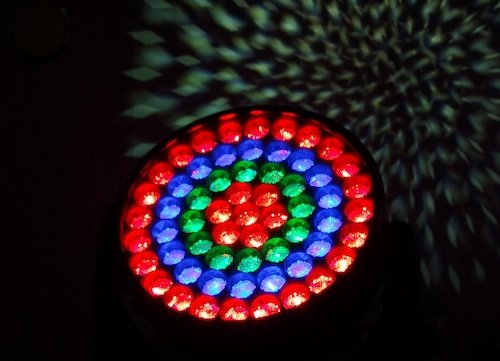On Stage Lighting puts an answer to a commonly asked question from beginners in modern stage lighting: Why do fixtures have different modes at all?
I spend most of my time teaching modern stage lighting techniques and in particular lighting programming and lighting systems. When you first learn about ‘moving lights’* and DMX lighting systems, you learn that there are few elements that must align to successfully control the fixtures. DMX Address and Mode. If these elements are not correct at the desk or the fixture, your system will not behave as you expect.
*A catch-all term for what I’d call ‘complex fixtures’ that have more than one channel of control.
One common question that I get early on from absolute beginners when you set up a few moving lights with them is why you might need a second universe. This is related to the the next question which is why a fixture has different modes. Why not just do one thing in one way, using up one chunk of DMX channels?

Fixture Mode Basics
To start with, let’s look at an example situation with a common simple fixture, an LED PAR. Even the most basic of these have a few modes of operation and each of them use up different numbers of DMX channels. Some modes might be:
- Red, Green, Blue – 3 Channels
- Red, Green, Blue, Dimmer – 4 Channels.
- Red, Green, Blue, Dimmer, Strobe, Effect, Colour Macro – 7 channels.
If this was more complex LED unit with more colours including Amber, White, UV, Colour Correction it would have many more channels, even in the most basic mode.
If a moving LED fixture could be split into different zones within the unit itself, this would also add to the channel count. E.g
- Zone 1: RGBWAU, Strobe, FX, Macro – 9 Channels
- Zone 2: RGBWAU, Strobe, FX, Macro – 9 Channels
- Zone 3: RGBWAU, Strobe, FX, Macro – 9 Channels
- Zone 4: RGBWAU, Strobe, FX, Macro – 9 Channels
- Zone 5: RGBWAU, Strobe, FX, Macro – 9 Channels
- Zone 6: RGBWAU, Strobe, FX, Macro – 9 Channels
This may be in addition to some channels that control some more global attributes such as Pan and Tilt and a bunch of others that are commonly found in modern fixtures. Before you know it, you have a fixture that uses 70+ channels. Now with a hard limit of 512 channels in a DMX universe, it becomes apparent why all but the simplest lighting system that involves complex fixtures needs two or more universes.
16-Bit – Fine Control
A big consideration with LED fixtures is the dimming and colour scales. You hope for, and don’t always get, pleasant dimming curves and the ability to make subtle changes to colour. DMX uses an 8-bit scale of control which means each channel has 256 steps in it, from 0 all the way up to 255. In order to get more steps of control, the fixture maker incorporates two channels of control for one item such as Dimmer or Red. They might be called Dimmer and Dimmer Fine. This is 16-bit control and when applied to each colour LED, each Dimmer channel plus Pan, Tilt, Focus etc. and it very often doubles the channel count for a complex fixture. In our example moving LED fixture, this might take it nearer to 140 channels.
Why have fixture modes?
Modern lighting fixtures are complex, particularly ones that move and have multiple colour mixing capabilities. Add 16-bit control to many attributes and you end up with a fixture that requires over 100 channels of control to just get it working. Not everyone wants to have to deal with that many channels. Not only does it require anything but the smallest of rigs to require more than 1 DMX universe, but there are many occasions when the user doesn’t want to have to wrangle 6 zones of 16-bit multi-colour mix fixture just to get a red splodge of light on the drummer.
Using a different mode can bring the complexity and channel count right down, in this case to perhaps 20 or so channels.
Fixture makers give the user different mode options so that they can cater for a large range of use cases, including as many features as possible while allowing the user to pick and choose which are the most important to them. This results in a simplest, smallest channel count mode, a complex, huge channel mode, and some inbetween. A lot of the time in professional lighting practice, the middle-sized modes are chosen for their balance between features and ease of control, plus being a little more frugal on the DMX channel count.
Having all of the features, all of the time, isn’t necessarily an attractive option. Fixture modes give us the choice.
Rob Sayer HND PGDip FHEA is a Senior Lecturer in Technical Theatre Production, mentor, and consultant in stage lighting and education. As a professional lighting designer, Rob designed and programmed theatre performances, music festivals and large corporate events for blue chip companies while travelling all over Europe. With a background in theatre, he combines traditional stage lighting knowledge alongside fast moving lighting and video technology in the world of commercial events.

